Familial Ankyloglossia -A Rare Report of three Cases in a Family
Ashwin Devasya1, Mythri Sarpangala2
1 Senior Lecturer, Department of Paedodontics and Preventive Dentistry, Kannur Dental College, Anjarakkandy, Kannur, Kerala, India.
2 Senior Lecturer, Department of Periodontology, Kannur Dental College, Anjarakkandy, Kannur, Kerala, India.
NAME, ADDRESS, E-MAIL ID OF THE CORRESPONDING AUTHOR: Dr. Ashwin Devasya, Bhat’s Multi Specialty Dental Clinic, Oberle Complex, Above Kottodal Hardwares, Badiyadka Road, Kumbla-671321, Kasargod, Kerala, India.
E-mail: ashwindkumbla@gmail.com
Inheritance patterns,Tongue-tie,T-box transcripition factor
Ankyloglossia, commonly known as ‘tongue-tie’, is a congenital oral anomaly characterized by the persistence of the lingual frenulum as an anatomical abnormality [1]. The Online Mendelian Inheritance in Man (OMIM) has given identification number for ankyloglossia as 106280 [2].
The prevalence reported in the literatures varies from 0.1% to 10.7%. In neonates the prevalence is 1.72% to 10.7%, while in adolescents or adults it ranges from 0.1% to 2.08% [3]. It affects males more commonly, in the ratio 3:1 [3].
There are very few cases of familial ankyloglossia reported till now. In this report, we have described a family affected with ankyloglossia in two generations inherited as an autosomal dominant or recessive trait. Five individuals in two generations were affected out of which three are described here. Most importantly, in this family females were affected more than males.
A parent came to our hospital with a complaint that his nine-year-old daughter has a difficulty in pronouncing few words. On intraoral examination it was found that the individual had ankyloglossia or tongue tie and was classified as Class 2 [Table/Fig-1], based on Kotlow’s assessment [4]. Parents were explained the reason, problems caused by the condition and the need for immediate treatment.
Case 1: A nine-year-old female diagnosed as Class 2 ankyloglossia based on Kotlows’s assessment.
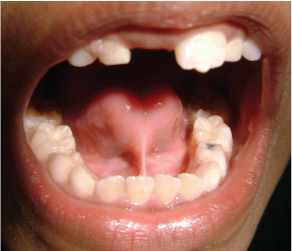
Interestingly, father also mentioned that his wife (the mother) and two of his daughters and a son also have the similar problem, son being their eldest child. There was no other history of tongue tie in their family. The other two daughters eight-year-and 11-year-old were also examined and we found that they have Class 3 [Table/Fig-2] and Class 2 [Table/Fig-3] type ankyloglossia respectively, based on Kotlow’s assessment.
Case 2: An eight-year-old female sibling with class 3 ankyloglossia based on Kotlows’s assessment.
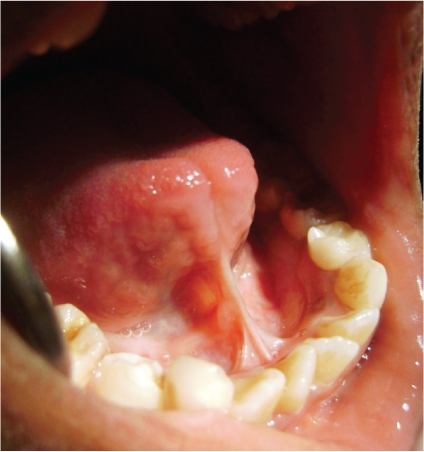
Case 3: An 11-year-old female sibling with Class 2 ankyloglossia based on Kotlows’s assessment.
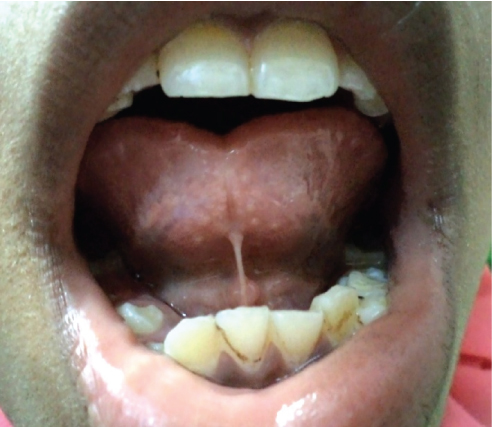
The son and the mother did not appear for the examination or the treatment. But based on the details given by the father we just have mentioned the incidence in this report which is not confirmative.
All the three children underwent frenectomy procedures using single haemostat method and were advised tongue exercises after a week. Follow up after a week showed remarkable healing of tissues [Table/Fig-4,5 and 6] and after six months there was reduction in pronunciation problems of the children.
Case 1: Follow up after a week showing good healing and extensibility of tongue.
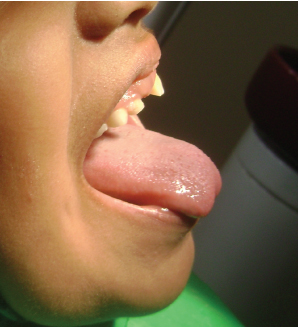
Case 2: Follow up after a week showing good healing and extensibility of tongue.
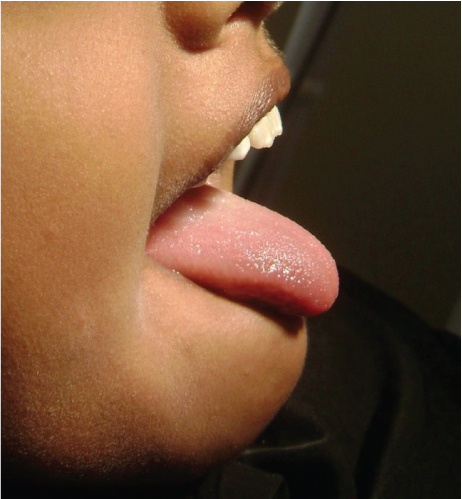
Case 3: Follow up after a week showing good healing and extensibility of tongue.
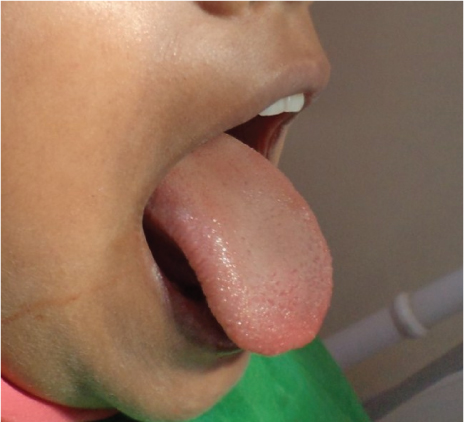
Discussion
Ankyloglossia is congenital and sometimes associated with various syndromes like Ehler Danlos syndrome, Beckwith Wiedemann syndrome, X-linked cleft palate and orofacial digital syndrome [5]. Ankyloglossia causes many problems like difficulty in breast feeding, difficulties in speech, oral hygiene, chewing food, stress and difficulty to wear a denture, in various stages of life [5]. For the purpose of treatment, there are various options available such as frenotomy, frenectomy, lasers and electrosurgery [4].
Familial ankyloglossia is a very rare condition. It has been reported that mutation of T-box transcripition factor (TBX22) gene during palatogenesis causes ankyloglossia [6].
Ankyloglossia can also be a part of X-linked cleft palate caused by mutations in the TBX22 gene. TBX22 is the sole phenotype in 4% of affected males and in 45% of carrier females. But in our cases, female predominance was more which seems to be rare [6].
Conclusion
Tongue tie is not a harmful condition and treating it at optimum time is safe and helpful in correction of problems. The familial occurrence of ankyloglossia is rare and uncommon. To understand the genetic aspect of it more studies should be done and explored.
[1]. Horton CE, Crawford HH, Adamson JE, Ashbell TS, Tongue-tie Cleft Palate J 1969 6:8-23. [Google Scholar]
[2]. Ankyloglossia. Online Mendelian Inheritance in Man. Available at: http://www.omim.org/entry/106280 as on 27th Sep 2016 [Google Scholar]
[3]. Ballard JL, Auer CE, Khoury JC, Ankyloglossia: Assessment, incidence, and effect of frenuloplasty on the beast feeding dyad Pediatrics 2002 110:e63 [Google Scholar]
[4]. Kotlow LA, Ankyloglossia (tongue-tie): A diagnostic and treatment quandary Quintessence Int 1999 30:259-62. [Google Scholar]
[5]. Suture VGA, Bronsteine MM, Ankyloglossia: Facts and myths in diagnosis and treatment J Periodontol 2009 80:1204-19. [Google Scholar]
[6]. Braybrook C, Doudney K, Marcano ACB, Arnason A, Bjornsson A, Patton MA, The T-box transcription factor gene TBX22 is mutated in X-linked cleft palate and ankyloglossia Nature Genet 2001 29:179-83. [Google Scholar]